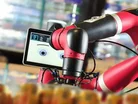Are these robots the future of factories and warehouses?

Pet food, aerosols, canned drinks and sweets - this robot packages them all. Sawyer robots are helping warehouses and factories cope with peaks in demand by being shifted around numerous sites and being programmed to handle several different tasks.
DHL Supply Chain has purchased four of them, the first step of its UKI robotics deployment programme. The robots will be flexibly used across its 19 co-packing and Production Logistics centres in the country.
Sawyer robots are some of the most advanced collaborative robots currently available and can support production and warehouse staff by automating repetitive tasks. The four robots will allow DHL to leverage automation flexibly, moving the robots between different sites in support of seasonal demands.
DHL is introducing the new technology in response to changing requirements from its customer base, who need to quickly meet peaks in demand. The new flexible approach ensures production lines are adjusting to change, while also providing additional capacity by filling gaps in the labour market.
Sawyer robots have been tested to ensure they have the highest health and safety credentials so they can work in collaboration with the workforce. The robots automatically stop if they touch something unexpected, which means that humans can physically be much closer to them without risk of harm. DHL will be upskilling its existing co-packing teams to support its growth and apply this new technology, hiring specialist roles such as Robotics Technicians, Project Engineers as well as other production management roles.
The four Sawyer robots have been bought following successful trials packing pet food, confectionery, aerosols and canned drinks. Following this initial investment, DHL plans a strategic investment of over £1 million in the next 12 months to enhance its commitment to robotics and automation.
Simon Woodward, Director of Co-Packing and Production Logistics at DHL Supply Chain, said: “The introduction of collaborative robotics into logistics is something we’ve been exploring at DHL for a while. After numerous trials, we are excited to now be offering our Sawyer robots as a solution to our co-packing customers’ needs.
“Our customers who work in consumer industries are seeing huge fluctuations in demand as consumer preferences change. The rise of ecommerce has led to a surge in the number of deliveries within the network and the flexible nature of Sawyer allows us to quickly respond to changing needs, delivering solutions to meet demands and fill labour gaps.”
DHL processes more than 50 million cases per annum from 19 co-pack centres nationwide and works with household names across a range of industries. It is now exploring how automation and robotics can be introduced at other points in the supply chain as well as at its co-packing and Production Logistics operations.
Featured Articles
SAP has announced it has appointed a new President for a newly-created EMEA region, aiming to make the most of the opportunities of cloud and AI technology
Technology giant SAP has expanded its portfolio with the acquisition of LeanIX, a leader in enterprise architecture management (EAM) software
To help businesses achieve increased productivity, Siemens and Microsoft are deepening their partnership by showcasing the benefits of generative AI



